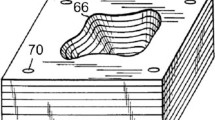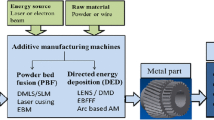Abstract
3D printing technology, also known as “additive manufacturing”, can be used to design highly complex structures to produce products quickly on demand and at low cost, and has great application prospects in rapid processing. The application of biomass materials in 3D printing can significantly reduce the negative impact of petroleum based materials on resource shortage and environment. Therefore, 3D printing of environmentally friendly materials has attracted extensive attention from researchers. This review introduces the preparation of biomass materials for 3D printing, fused deposition modeling (FDM), direct ink writing (DIW), selective laser sintering (SLS), laminated object manufacturing, and the characterization method of biomass-based 3D printing materials.
Access this chapter
Tax calculation will be finalised at checkout
Purchases are for personal use only
Similar content being viewed by others
References
Conner, B.P., et al.: Making sense of 3-D printing: creating a map of additive manufacturing products and services. Smart Mater. Struct. 1, 1310–1311 (2015)
Mohamed, O.A., Masood, S.H., Bhowmik, J.L.: Optimization of fused deposition modeling process parameters: a review of current research and future prospects. Adv. Manuf. 3(1), 42–53 (2015). https://doi.org/10.1007/s40436-014-0097-7
Sochol, R.D., et al.: 3D printed microfluidics and microelectronics. Microelectron. Eng. 189, 52–68 (2018)
Haque, R.I., et al.: Self-powered triboelectric touch sensor made of 3D printed materials. Nano Energy 52, 54–62 (2018)
Destino, J.F., et al.: 3D printed optical quality silica and silica–titania glasses from sol–gel feedstocks. Adv. Mater. Technol. 3(6) (2018)
Fan, Z., Feng, H.: Study on selective laser melting and heat treatment of Ti-6Al-4V alloy. Results Phys. 10, 660–664 (2018)
Ledford, C., et al.: Characteristics and processing of hydrogen-treated copper powders for EB-PBF additive manufacturing. Appl. Sci. (Switzerland) 9(19) (2019)
Sochol, R.D., et al.: 3D printed microfluidic circuitry via multijet-based additive manufacturing. Lab Chip 16(4), 668–678 (2016)
Ji, A., et al.: 3D printing of biomass-derived composites: application and characterization approaches. RSC Adv. 10(37), 21698–21723 (2020)
Yoo, C.G., et al.: The critical role of lignin in lignocellulosic biomass conversion and recent pretreatment strategies: a comprehensive review. Bioresour. Technol. 301, 122784 (2020)
Pérez, J., et al.: Biodegradation and biological treatments of cellulose, hemicellulose and lignin: an overview. Int. Microbiol. 5(2), 53–63 (2002)
Julie, C., Thomas, B.: Cellulose: from biocompatible to bioactive material. J. Mater. Chem. B 2(30), 4767–4788 (2014)
Siqueira, G., et al.: Cellulose nanocrystal inks for 3D printing of textured cellular architectures. Adv. Func. Mater. 27(12), 1604619 (2017)
Dong, J., et al.: The influence of grafted cellulose nanofibers and postextrusion annealing treatment on selected properties of poly(lactic acid) filaments for 3D printing. J. Polym. Sci. Part B: Polym. Phys. 55(11), 847–855 (2017)
Hong, H.-J., et al.: Fabrication of cylindrical 3D cellulose nanofibril (CNF) aerogel for continuous removal of copper (Cu2+) from wastewater. Chemosphere 278, 130288 (2021)
Baniasadi, H., et al.: High-resolution 3D printing of xanthan gum/nanocellulose bio-inks. Int. J. Biol. Macromol. 209, 2020–2031 (2022)
Shin, S., Kwak, H., Hyun, J.: Transparent cellulose nanofiber based open cell culture platform using matrix-assisted 3D printing. Carbohydr. Polym. 225, 115235 (2019)
Ragauskas, A.J., et al.: Lignin valorization: improving lignin processing in the biorefinery. Science 344(6185), 1246843 (2014)
Zhang, S., et al.: Stereolithography 3D printing of lignin-reinforced composites with enhanced mechanical properties. ACS Omega 4(23), 20197–20204 (2019)
Fan, Q., et al.: Water-induced self-assembly and in situ mineralization within plant phenolic glycol-gel toward ultrastrong and multifunctional thermal insulating aerogels. ACS Nano 16(6), 9062–9076 (2022)
Abdullah, T., et al.: Development of nanocoated filaments for 3d fused deposition modeling of antibacterial and antioxidant materials. Polymers 14(13) (2022)
Liu, Z., et al.: Impact of rheological properties of mashed potatoes on 3D printing. J. Food Eng. 220, 76–82 (2018)
Giubilini, A., et al.: 3D-Printing nanocellulose-poly(3-hydroxybutyrate-co-3-hydroxyhexanoate) biodegradable composites by fused deposition modeling. ACS Sustain. Chem. Eng. 8(27), 10292–10302 (2020)
Jiang, G., et al.: Investigation into hydroxypropyl-methylcellulose-reinforced polylactide composites for fused deposition modelling. Ind. Crops Prod. 146, 112174 (2020)
Adams, D., Ounaies, Z., Basak, A.: Printability assessment of ethyl cellulose biopolymer using direct ink writing. JOM 73(12), 3761–3770 (2021). https://doi.org/10.1007/s11837-021-04911-8
Baniasadi, H., et al.: Direct ink writing of aloe vera/cellulose nanofibrils bio-hydrogels. Carbohydr. Polym. 266, 118114 (2021)
Ajdary, R., et al.: Selective laser sintering of lignin-based composites. ACS Sustain. Chem. Eng. 9(7), 2727–2735 (2021)
Wörz, A., Drummer, D.: Tribological anisotropy of selective laser sintered PA12 parts. Polym. Test. 70, 117–126 (2018)
Ma, H., Suhling, J.C.: A review of mechanical properties of lead-free solders for electronic packaging. J. Mater. Sci. 44(5), 1141–1158 (2009). https://doi.org/10.1007/s10853-008-3125-9
Long, H., et al.: Mechanical and thermal properties of bamboo fiber reinforced polypropylene/polylactic acid composites for 3D printing. Polym. Eng. Sci. 59(s2), E247–E260 (2019)
Ibrahim, F., et al.: Evaluation of the compatibility of organosolv lignin-graphene nanoplatelets with photo-curable polyurethane in stereolithography 3D printing. Polymers 11(10) (2019)
Mimini, V., et al.: Compatibility of kraft lignin, organosolv lignin and lignosulfonate with PLA in 3D printing. J. Wood Chem. Technol. 39(1), 14–30 (2019)
Kuo, C.-C., et al.: Preparation of starch/acrylonitrile-butadiene-styrene copolymers (ABS) biomass alloys and their feasible evaluation for 3D printing applications. Compos. Part B: Eng. 86, 36–39 (2016)
Tanase-Opedal, M., et al.: Lignin: a biopolymer from forestry biomass for biocomposites and 3D printing. Materials 12(18) (2019)
Agnoli, E., et al.: Additive manufacturing of geopolymers modified with microalgal biomass biofiller from wastewater treatment plants. Materials 12(7) (2019)
Nguyen, N.A., Bowland, C.C., Naskar, A.K.: Mechanical, thermal, morphological, and rheological characteristics of high performance 3D-printing lignin-based composites for additive manufacturing applications. Data Brief 19, 936–950 (2018)
Wilkie, C.A.: TGA/FTIR: an extremely useful technique for studying polymer degradation. Polym. Degrad. Stab. 66(3), 301–306 (1999)
Forrest, J.A., Dalnoki-Veress, K.: The glass transition in thin polymer films. Adv. Colloid Interface Sci. 94(1), 167–195 (2001)
Wellen, R.M.R., Rabello, M.S.: The kinetics of isothermal cold crystallization and tensile properties of poly(ethylene terephthalate). J. Mater. Sci. 40(23), 6099–6104 (2005)
Shariatnia, S., et al.: Atomization of cellulose nanocrystals aqueous suspensions in fused deposition modeling: a scalable technique to improve the strength of 3D printed polymers. Compos. Part B: Eng. 177, 107291 (2019)
Tekinalp, H.L., et al.: High modulus biocomposites via additive manufacturing: cellulose nanofibril networks as “microsponges”. Compos. Part B: Eng. 173, 106817 (2019)
Wang, L., et al.: Spray-dried cellulose nanofibril-reinforced polypropylene composites for extrusion-based additive manufacturing: nonisothermal crystallization kinetics and thermal expansion. J. Compos. Sci. 2(1) (2018)
Acknowledgements
This work has been supported by the National Natural Science Foundation(61973127); Science and Technology Program of Guangdong Province (2017B090901064); SCUT Liyan (Guangdong) New Material Technology Co., Ltd (High-tech industrialization entrepreneurship team project of Foshan High-tech Zone, FSBG2021021); Guangdong Basic and Applied Basic Research Foundation) (No.2021A1515010899).
Author information
Authors and Affiliations
Corresponding author
Editor information
Editors and Affiliations
Rights and permissions
Copyright information
© 2023 The Author(s), under exclusive license to Springer Nature Singapore Pte Ltd.
About this paper
Cite this paper
Zhao, H., Jia, Y., Chen, G., He, M., Tian, J., Chen, Q. (2023). Research Status and Progress of Biomass-Based 3D Printing Materials. In: Xu, M., Yang, L., Zhang, L., Yan, S. (eds) Innovative Technologies for Printing and Packaging. CACPP 2022. Lecture Notes in Electrical Engineering, vol 991. Springer, Singapore. https://doi.org/10.1007/978-981-19-9024-3_79
Download citation
DOI: https://doi.org/10.1007/978-981-19-9024-3_79
Published:
Publisher Name: Springer, Singapore
Print ISBN: 978-981-19-9023-6
Online ISBN: 978-981-19-9024-3
eBook Packages: EngineeringEngineering (R0)




